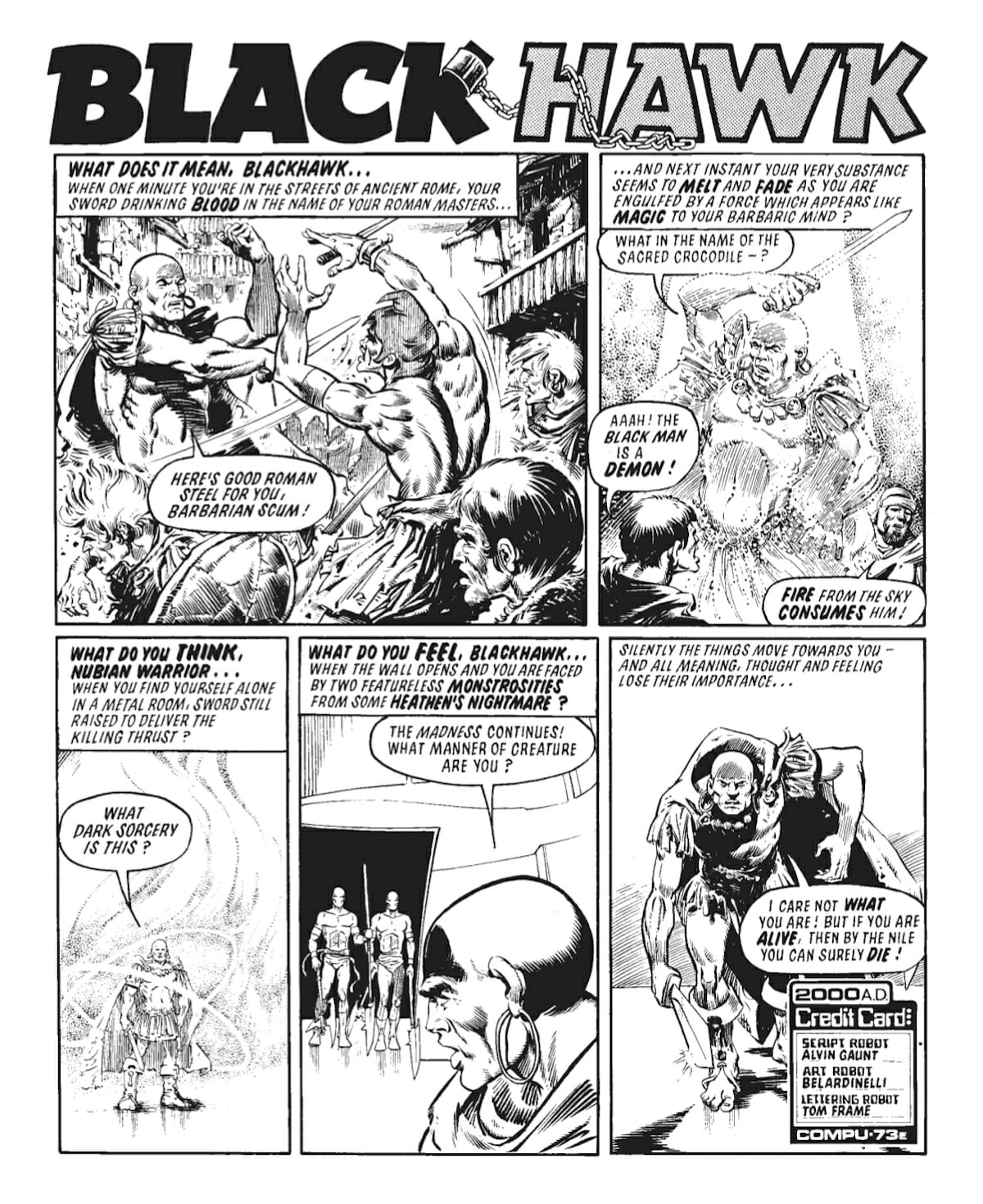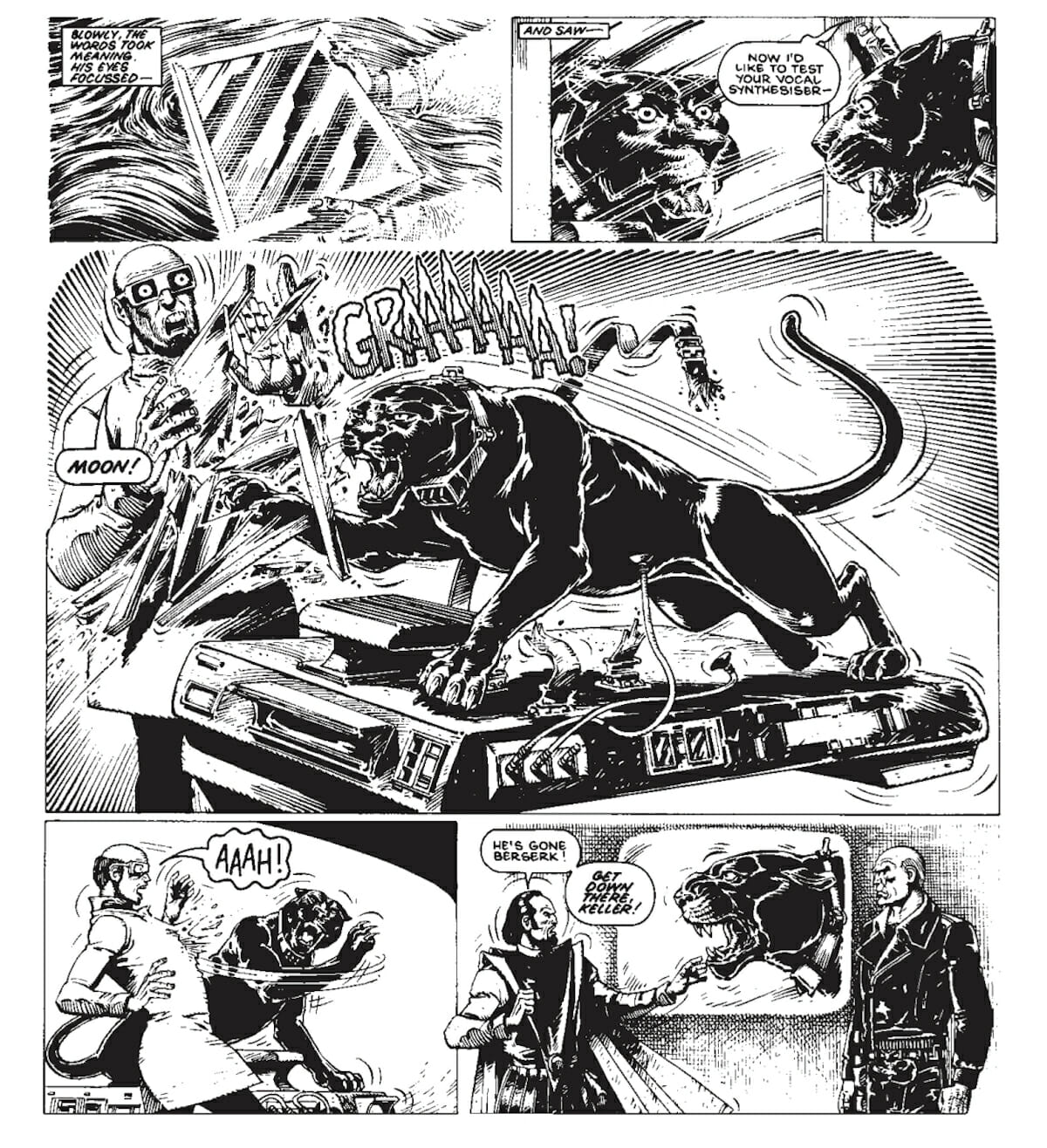There’s a quote that comes to mind whenever I think of Italian comic artist Massimo Belardinelli. It’s not from Meltdown Man, Dan Dare, Slaíne, or even Ace Garp of Ace Trucking Company — all titles and characters that Belardinelli is revered for — but instead, it’s a quote from writer Alan Grant in 2007’s oral history of 2000 AD, Thrill Power Overload, talking about Belardinelli’s art style:
“[…] Massimo’s artwork was beautiful, often more beautiful than the script called for — he had such a lovely brush stroke […] but no offense meant to anyone, but all the guys in Massimo’s strips looked a bit limp-wristed.”
While it’s easy (and also correct) to deem this passage as poorly-dated and offensive, I can honestly think of no way to better highlight the talent and dichotomy of the artwork and visual storytelling behind the pens and pencils of Belardinelli, one of the unsung greats of the first decade of 2000 AD’s existence.
Born in Rome in the early 20th century, Belardinelli’s career began adjacent to comics, in cartoon animation, painting backgrounds for the Sergio Rosi studio in Italy. When the studio took over art for British anthology title Valiant’s “The Steel Claw” strip, however, the door to comics swung itself open, with Belardinelli beginning his comics career doing background work alongside Sergio Rosi himself. After a successful year in the background of some of Britain and Europe’s most beloved comics, Belardinelli was then able to move on to the wonderfully raunchy erotic comics of Messalina and Jacula, and later American publisher Gold Key Comics’ Star Trek, as well as numerous strips for the iconic Fleetway Publications in the UK.
Perhaps more notably though, Belardinelli was a key figure within the early pages of* 2000 AD*, first getting his official scifi big break as the new artist on a revamped version of Dan Dare in the earliest issues of the title, at the same time as he illustrated The Rat Pack in 2000 AD stablemate anthology, war comic Battle, a series noted for the sophistication in its art, paired with an otherwise ordinary Battle Dirty Dozen-style story.
Although his work remained consistently unpopular among adult readers of the comics — kids, thankfully, recognized his talents more easily — Belardinelli’s career soared with bylines and impeccable drawings done for the second series of Flesh, as well as Angry Planet. When sibling anthology Tornado found itself merged with 2000 AD in the early 1980s, it brought the fantasy strip Blackhawk with it — giving Belardinelli another high-profile opportunity to set a new precedent for sci-fi art that hinted to readers to perhaps not quite take themselves, or the stories, quite so seriously.
Between Meltdown Man and Ace Trucking Co. — two 2000 AD mainstays in the early 1980s that are undeniably some of the artist’s most easily recognized works — it’s hard to deny that Belardinelli had a rare gift not only for the bizarre, but also for fun. For all that Meltdown Man may be a totally ridiculous concept in terms of its writing, the artwork ties the story together in a way that only Belardinelli can do, weaving the strange scifi concepts of hybrid people and the urgency of the genocide he must save them from are dispersed with camp faces, undeniably horny animal-folk, and stunning backgrounds in way that makes readers both fully engaged and utterly befuddled.
The same can be said, in the best of ways, for his work on John Wagner and Alan Grant’s Ace Trucking Co. Ace Trucking is memorable and still held in the highest regard by fans for a number of reasons ranging from the UK’s strange obsession with CB radio chatter in the 1980s to Wagner and Grant’s signature goofiness laced with sci-fi fun. More than that, though, when you think of Ace Trucking, you think of the art. With a style of art that is so fine-tuned and beautiful that it almost looks out of place for the likes of Wagner and Grant’s tomfoolery, the series was a place for Belardinelli’s imagination to run wild.
With the series artist having been pegged as someone whose human figures were, ahem, “limp wristed”, Wagner and Grant intentionally created an alien space hauling comedy with nearly no humans in sight — creating a space filled by the fever-dreams of Bellardinelli’s brain sprawling out in the form of hulking figures, sly-talkers, and massive prog rock space backgrounds. Somewhere between the believable and the absurd was where Belardinelli’s abilities truly shone, showing audiences what Ace Trucking was all about, and just how genuinely weird it truly was. Honestly, there is no better way to picture it.
Belardinelli continued to draw many strips and comics even when his career with 2000 AD slowly came to an end, having spent much of just over a decade acting as a major player in the smaller aspects of the title during its formative years. Despite having never touched anything like Judge Dredd, Rogue Trooper, or Strontium Dog — some of the title’s biggest serials of the era — it’s an undeniable fact that Belardinelli’s work nonetheless was the backbone of the smaller (and still infinitely beloved) characters and concepts that helped shape both 2000 AD as an anthology, and a fanbase that grew up with specific ideas of what did, and didn’t, constitute the much-beloved “thrill power” that readers clamored for.
There are few artists in the world whose quality of art manages to be so phenomenal and deadly serious, but lends itself so well to levity, lightness, and fun. In Belardinelli’s work, we as fans can relish in just that: the simplicity of a comic book laugh delivered with quality, thoughtfulness, and an imagination that was beyond what anyone was able to cope with.






